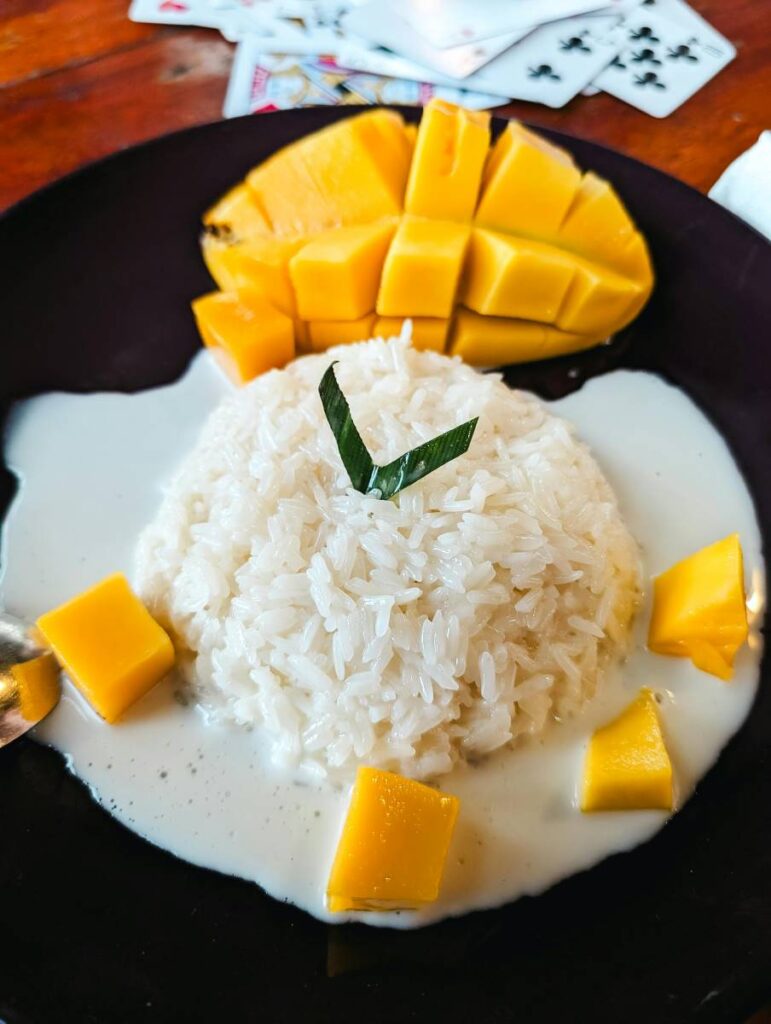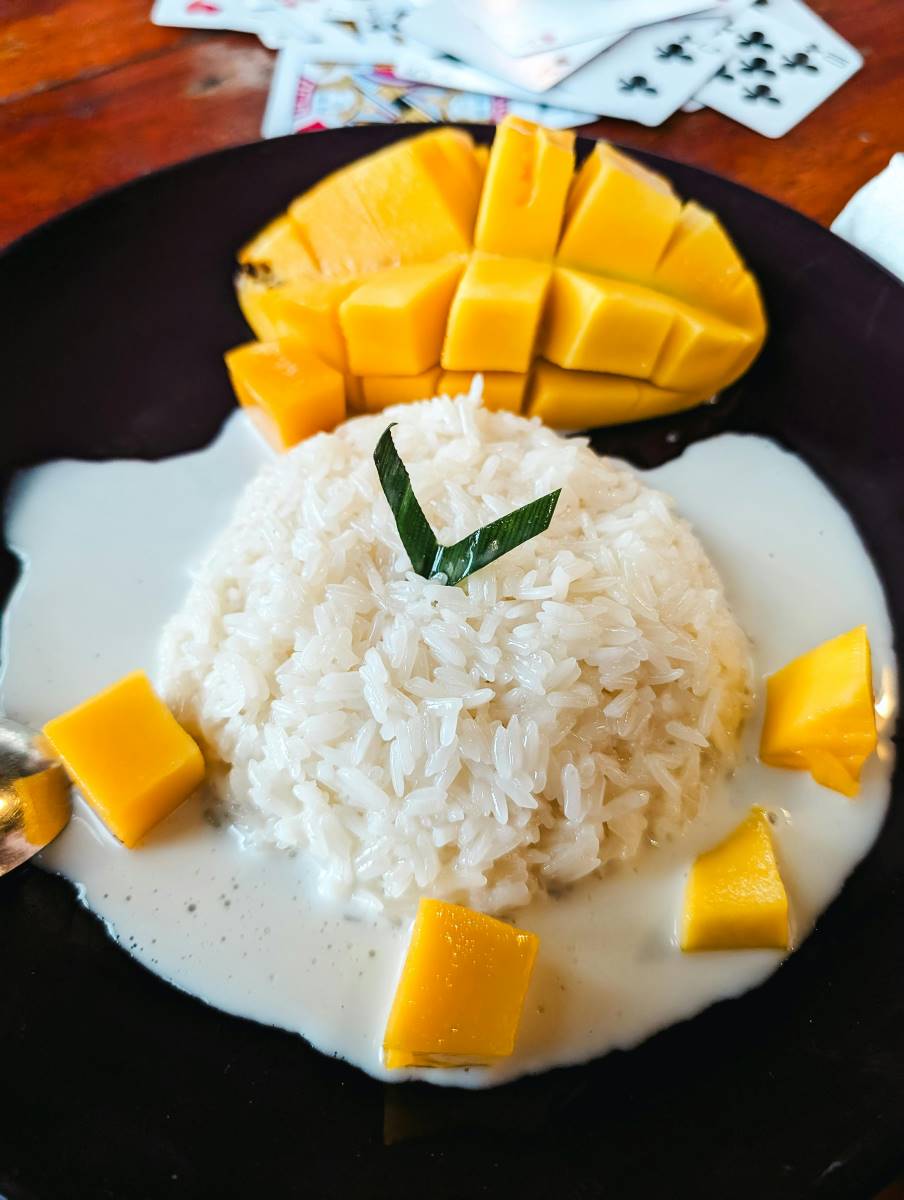Mango sticky rice is more than just a dessert. It’s a way to feel joy. I want to share how to make this treat at home. I’ll tell you all about it. From picking the best mangoes to serving the dish with flair.
Let me take you on a trip to learn about this sweet dish. We will go step by step. You will learn how to cook the rice just right. You will see how to make the coconut sauce creamy. And you will find out how to pick the perfect mango.
I first tried mango sticky rice on a trip to Thailand. It was a hot day in Bangkok. A street seller handed me a small pack. The rice was warm. The mango was cool. The taste was like nothing I had tried before. Since then, I’ve made it many times at home. Now I can share what I’ve learned with you.
Table of Contents
What Is Mango Sticky Rice?

Mango sticky rice is a Thai dessert. Its Thai name is “khao niew mamuang.” It has three main parts. There is sticky rice. There is sweet coconut sauce. And there is fresh mango.
The dish is big in Thailand. You can find it in nice sit-down places. You can also buy it from street carts. It’s most common in the hot months. This is when mangoes are ripe and sweet.
The dish brings together many tastes. You get the soft rice, you taste the sweet mango, you feel the rich coconut milk. All these work as one to make a treat that’s both simple and grand.
Also read, How to Make Mango Lassi: A Step-by-Step Guide.
The Key Parts of Mango Sticky Rice
Let’s look at what goes into this dish:
- The rice must be sticky rice. This is not the same as white rice you may know. Sticky rice has a lot of starch. This makes it stick together when cooked.
- The mango should be ripe and sweet. In Thailand, they use a type called Nam Dok Mai. These are sweet with a soft, smooth feel. If you can’t find these, use any ripe mango with few strings.
- The sauce is made from coconut milk. It’s mixed with sugar and a bit of salt. Some folks add a touch of rice flour to make it thick.
- On top, you may see toasted mung beans or sesame seeds. These add a nice crunch to each bite.
Picking the Right Mango
The mango makes or breaks this dish. You want one that is just right.
Look for a mango that gives a bit when you press it. Too firm means it’s not ripe yet. Too soft means it may be past its prime.
Smell the mango at its stem. A ripe one will have a sweet smell. If there’s no smell, it needs more time.
The color can help too. Most ripe mangoes turn a deep yellow or orange. Some types stay green even when ripe, so feel and smell are your best guides.
I like to buy mangoes a few days before I plan to make the dish. This gives them time to ripen if they need it. To speed up the process, put them in a paper bag with a ripe banana.
Types of Rice to Use
You must use glutinous rice, also known as sticky rice. This is key. Don’t try to swap it with jasmine or long-grain rice. The dish won’t be the same.
Sticky rice has a high starch level. This is what makes it stick. You can find this rice in Asian food shops. You might see it called “sweet rice” or “glutinous rice.”
The rice comes in two main types: white and black. The white type is most common for this dish. But some chefs use black sticky rice for a twist. Black rice takes more time to cook and has a nuttier taste.
Before you cook sticky rice, you must wash it well. Then let it soak for at least four hours. Some chefs soak it all night. This step is key. It helps the rice cook up soft and chewy.
Tools You’ll Need
To make mango sticky rice the true Thai way, you would use some tools:
- A bamboo basket and pot are best for steaming the rice. This lets the rice steam in the right way. But you can use a metal steamer too.
- You’ll need a pot to heat the coconut milk sauce.
- A sharp knife helps cut the mango in a neat way.
- Small bowls or plates work well to serve each part.
If you don’t have all these tools, don’t worry. You can still make a good version of the dish with what you have. The key is to steam the rice, not boil it.
Step-by-Step Guide to Making Mango Sticky Rice
Now, let’s make this dish. I’ll break it down into clear steps.
Step 1: Prep the Rice
Start with one cup of sticky rice. Rinse it in cold water. Keep rinsing until the water runs clear. This gets rid of excess starch.
Put the rice in a bowl. Add enough water to cover it by an inch. Let it soak for at least 4 hours. I like to do this step the night before.
After the rice has soaked, drain it well. Shake off any extra water.
Step 2: Cook the Rice
Set up your steamer. Add water to the pot, but make sure it won’t touch the rice.
Line your steamer basket with a clean cloth or cheesecloth. This stops the rice from falling through.
Spread the rice out in the basket. Don’t pile it too high. You want the steam to reach all the rice.
Cover and steam for 20-25 minutes. The rice should be soft but still have a slight chew.
While the rice cooks, you can prep the sauce and mango.
Step 3: Make the Coconut Sauce
In a pot, mix one can (about 13.5 oz) of coconut milk with half a cup of sugar and a pinch of salt.
Heat this mix on low. Stir often. Don’t let it boil. You just want the sugar to melt.
When the sugar has mixed in, take half of this sauce and set it aside. This part will go on the rice.
Add a mix of one teaspoon of rice flour and two teaspoons of water to the sauce still on the heat. This will make a thicker sauce to serve on top.
Keep stirring until it gets a bit thick. Then turn off the heat.
Step 4: Mix the Rice with Sauce
When the rice is done, put it in a bowl. Pour the first half of the coconut sauce over it.
Stir the rice well. You want each grain to get coated. Let it sit for 10 minutes. This helps the rice soak up the sweet taste.
Step 5: Prep the Mango
Pick a ripe mango. Wash it and dry it.
Stand the mango on its end. Cut down on each side of the flat seed in the middle. This gives you two big pieces.
Score each piece in a grid. Don’t cut through the skin. Then push the skin up to make the cubes pop out.
Cut the cubes away from the skin. Set them aside.
Step 6: Serve the Dish
Put a scoop of the sweet coconut rice on a plate.
Place mango slices or cubes next to it.
Drizzle some of the thick coconut sauce on top.
If you like, add some toasted mung beans or sesame seeds for crunch.
Serve right away. The dish is best when the rice is still a bit warm and the mango is cool.
Tips for Perfect Mango Sticky Rice
I’ve made this dish many times. Here are some tips I’ve learned:
- Don’t skip the soaking step for the rice. It’s key for the right feel.
- Make sure to use canned coconut milk, not the thin kind you find in cartons.
- If your sauce splits or looks grainy, just whisk it well. It will come back together.
The dish is best served fresh. But you can keep the parts for a short time. Store the rice, sauce, and mango in the fridge. Just warm the rice and sauce a bit before you serve.
Try not to use a mango that’s too ripe. It should be sweet but still firm enough to cut neatly.
Don’t add too much sauce to the rice at first. You can always add more to taste.
Fun Ways to Serve Mango Sticky Rice
The basic dish is great. But there are fun ways to change it up:
- Serve it in a mango half. This looks nice and adds more mango taste.
- Make small balls of the sweet rice. Put a small piece of mango in the middle of each. This makes a bite-sized treat.
- Add a scoop of ice cream on the side. The cold ice cream goes well with the warm rice.
- Use a mix of mango types if you can find them. This adds color and taste range.
- Top with a mint leaf for a pop of color and a fresh note.
The Story Behind Mango Sticky Rice
Mango sticky rice has deep roots in Thai food culture. It’s not just a random sweet. It’s a dish that shows what grows well in the land.
Rice is a main food in Thailand. It’s in most meals. Sticky rice is big in the north and east of the country.
Mangoes grow well in the hot Thai weather. When they’re in season, they’re all over the place.
Coconut trees line the coasts and fill the farms. Fresh coconut milk is a common thing to cook with.
So, the dish brings together three things that are key to Thai food. It’s a smart use of local goods. And it’s a way to enjoy the sweet mangoes that grow in the hot months.
Health Notes on Mango Sticky Rice
Let’s be clear: this is a treat. It has lots of good things, but it’s also rich.
The mango gives you vitamins. It has A and C, which help your body in many ways.
Coconut milk has fats. But some say these are good fats that can help your heart.
The rice gives you energy. It has carbs that fill you up.
But the dish also has a good amount of sugar. So, it’s best to have it as a now-and-then treat, not an every day food.
If you want to make it a bit less rich, you can:
- Use less sugar in the sauce.
- Serve more mango and less rice.
- Skip the extra sauce on top.
When to Serve Mango Sticky Rice
This dish works well for many times:
- It’s a great end to a Thai meal. If you make a meal of pad thai or green curry, this is the perfect sweet note to end on.
- It’s nice for a warm day. The cool mango and the rich rice hit the spot when it’s hot out.
- It’s good for a group. You can set out the parts and let folks build their own plate.
- It’s a fun way to try new things with kids. Most kids like the sweet taste and the fun mix of warm and cool.
My Own Journey with Mango Sticky Rice
I first had this dish on a trip to Thailand. I was in a small town near Chiang Mai. A lady at a food stand made it fresh for me. She used a mango she had just cut from a tree. The rice was still warm from her steamer.
That first bite was a moment I won’t forget. The sweet mango, the soft rice, the rich sauce – all of it came together in a way that made me smile.
When I got home, I tried to make it. My first try was not so good. The rice was too wet. The mango wasn’t ripe enough. But I kept at it.
I asked Thai friends for tips, I read up on how to pick the right mango. I learned the trick of steaming, not boiling, the rice.
Each time I made it, it got a bit better. Now, it’s a dish I’m proud to share with my own guests. And each time I make it, I think of that small town in Thailand and the kind lady who first showed me this treat.
Common Problems and How to Fix Them
If you run into snags, here’s how to fix them:
- Rice too hard: It needs more time to soak or steam. Next time, soak it longer or steam it a few more minutes.
- Rice too soft: You may have used too much water or steamed it too long. Try less water or less time.
- Sauce too thin: Add a bit more of the rice flour mix. Or just let it cook a bit longer to thicken up.
- Sauce too thick: Add a splash more coconut milk and stir well.
- Mango not sweet enough: Try a drizzle of honey on top. Or mix a bit of sugar into the mango cubes.
Mango Sticky Rice Around the World
While this is a Thai dish at heart, you can find forms of it in other spots:
- In Laos, they make a like dish. They call it khao niew mamuang too.
- In some parts of Vietnam, you might find a take on it with local types of mangoes.
- In the West, chefs have put their own spin on it. Some add spices like star anise or cinnamon. Others mix in fruits like lychee or pineapple.
- No matter where you find it, the core stays the same: sweet rice, ripe mango, and rich coconut milk.
The Joy of Mango Sticky Rice
There’s a joy to this dish that goes past taste. It’s in the bright colors, It’s in the mix of warm and cool. It’s in the way it makes you slow down and savor.
When you eat mango sticky rice, try to take your time. Feel the soft give of the rice. Taste the sweet burst of the mango. Let the rich sauce coat your tongue.
It’s a dish that asks you to be in the moment. To put down your phone. To just sit and enjoy.
In a world that moves so fast, there’s a gift in a dish that makes you pause. That’s the real magic of mango sticky rice.
Final Thoughts
I hope this guide helps you make a great mango sticky rice at home. Don’t get too caught up in making it just right the first time. Like any dish, it takes a try or two to get the feel for it.
The key is to use good parts. Ripe mangoes. Quality coconut milk. The right kind of rice. With these, even a simple take on the dish will be tasty.
As you get more at ease with it, you can start to play. Try black sticky rice. Add a hint of salt to bring out the sweet. Serve it in new ways.
But most of all, share it. This is a dish meant to be part of a good time with folks you care about. It’s a way to bring a bit of Thai joy to your own table.
So, soak that rice. Slice that mango. Stir that sauce. And get ready for a treat that’s been making folks smile for years and years.

